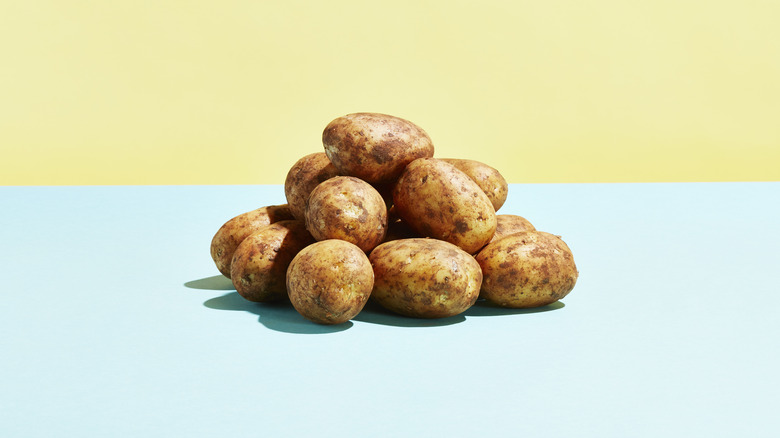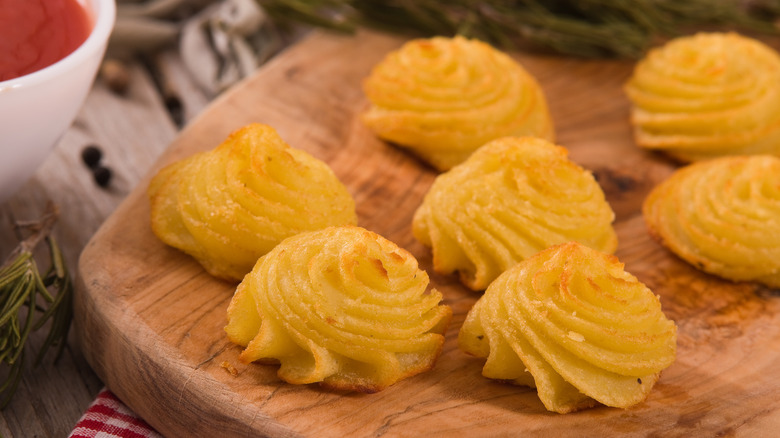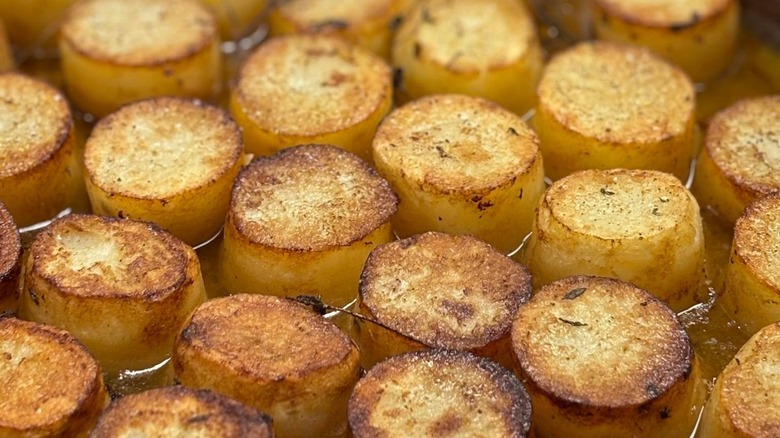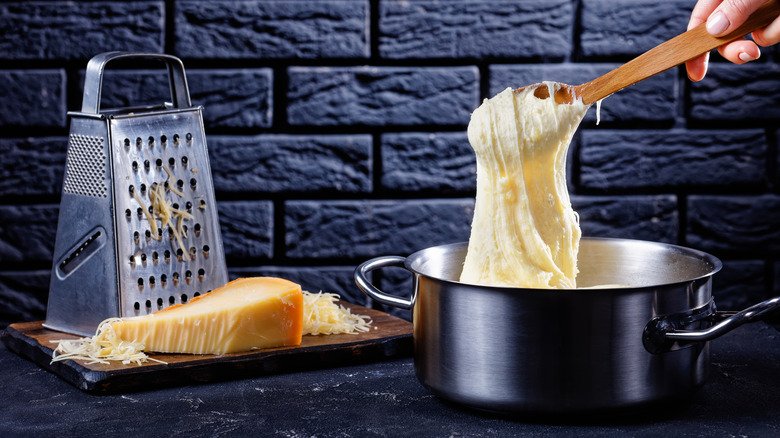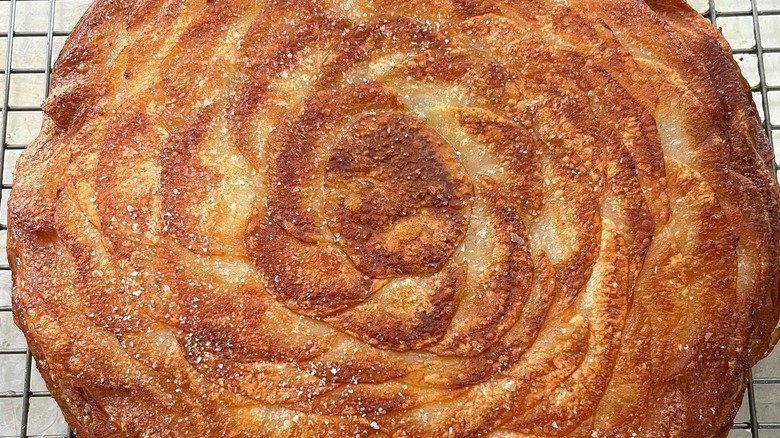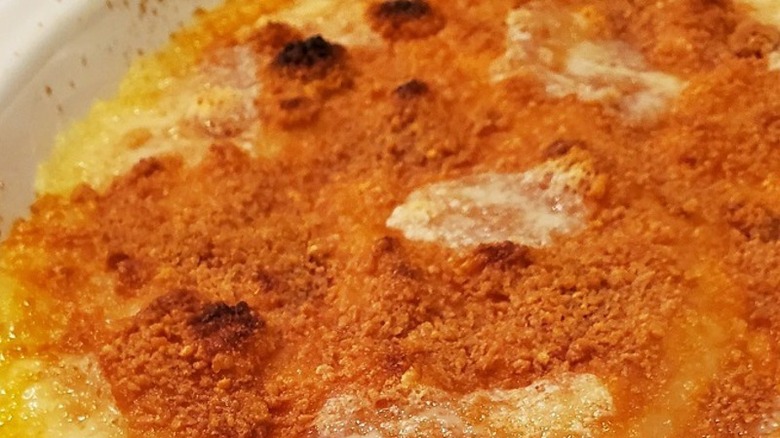5 Fancy Potato Side Dishes You Should Stop Overlooking
Potatoes are the go-to choice for side dishes, from the humble French fry to the vaunted potato gratin. It's also easy to see why we keep reaching for a side of spuds, as they are affordable, widely-available, and pair beautifully with practically any meat entrée. No menu of steakhouse sides is complete without some kind of potato dish, but the potato's ubiquitous nature can be a double-edged sword. As delicious as they are, potatoes aren't exactly the most inspired choice, and they risk coming off as a bit run-of-the-mill.
Nobody can argue that mashed potatoes aren't a consummate crowd pleaser, or that a side of rosemary and garlic roasted potatoes doesn't make a perfect mate for any main, but if you've already perfected these recipes, it might be time to explore further afield. There are a lot of fantastic potato side dishes worth trying out, especially if you're going for a fancier presentation. If you're looking to bring a bit of haute cuisine to your next dinner party, here are five fancy potato side dishes you ought to consider.
Duchess potatoes make the most of your mash
Duchess potatoes, or pommes duchesse, are a classic side dish from France. They are essentially a fancy way to upgrade mashed potatoes. The dish calls for boiling and mashing potatoes before folding in heavy cream and egg yolks. The mixture is then put into a piping bag fitted with a star tip, and piped in swirly little mounds that almost resemble roses. The final step entails brushing the piped potatoes with butter and baking them to give the spuds a golden brown edge.
The dish has an illustrious history dating back to the early 1800s. It's likely the name was chosen not to honor a specific noblewoman, but rather to project an air of wealth and class. It worked, as duchess potatoes have been served to some of America's most prominent political figures. They were particularly popular in the mid-20th century, and featured at state dinners for presidents Dwight D. Eisenhower, John F. Kennedy, and Lyndon Johnson.
The trick to making proper duchess potatoes is all in the piping. Shaping by hand is possible, as attested to by early recipes from Auguste Escoffier and Julia Child, among others. However, this way is more arduous, and won't give you the same rosy shapes you get from piping. Aim for tight circles when piping out the potatoes, and don't leave any hollow spots, lest they collapse. The egg yolks are your friend here. They not only add richness to the dish but help the potatoes retain their shape.
Fondant potatoes are fork tender
For a potato side dish that requires a little less precision, but produces no less delightful results, consider fondant potatoes, or pommes de terre fondantes. The French name means "melting potatoes," which alludes to the texture of this ultra creamy side dish. Although fondant potatoes aren't very common on American menus, they are a longstanding favorite in Europe, particularly France and England, and it's high time they got their flowers here across the pond. The technique is actually quite simple, and it essentially entails cooking potatoes in the same way you would make a braised meat dish.
Fondant potatoes are made with either Russet or Yukon Gold potatoes, peeled and cut into small cylinders between 1½ and 2 inches tall. The potatoes get seared in a pan until they are browned on both sides, then, you add butter and aromatic herbs, cooking until they are fragrant. Crucially, you need to add some chicken stock to the pan and finish it off in the oven, slow-cooking the potatoes in the flavorful broth for about a half hour, until they yield to your fork.
Peeling and cutting all the potatoes into cylinders of equal thickness can be a bit time-consuming, but the cooking process is quite simple and largely inactive, allowing you to work on other dishes while the potatoes finish off in the oven. The individual cylinders look lovely when plated up with some of the cooking liquid poured over the top as a sauce.
Aligot is for cheese lovers
Aligot is what would happen if mashed potatoes and cheese fondue merged into one creamy, dreamy dish. It is essentially a dish of mashed potatoes mixed with heavy cream and an absolutely ungodly amount of shredded cheese. Usually, when you're making mashed potatoes, you don't want to stir them around too much, lest you overwork the mixture and turn it into a sticky paste, but with aligot, that's actually exactly what you want. Start by making a standard batch of mashed potatoes, then whip them constantly as you add in heavy cream and cheese. The final result should be smooth and stretchy.
This is a particularly hardy side dish. Aligot was actually invented by 12th century monks for the purpose of feeding Christian pilgrims on an arduous journey by foot, although the dish has traveled far from these humble roots to become a fixture of fine dining restaurants and mouth-watering Instagram videos. The biggest challenge of making aligot is getting the right cheese. In France, it is traditionally made with a cheese called tomme fraîche, but this is incredibly difficult to find in the United States, so you will have to substitute another quality melting cheese such as Gruyère or Fontina. Be generous with the cheese. Part of the fun appeal of aligot is watching the dramatic potato-cheese pull as the chef stirs and serves it.
Pommes Anna will get you points for presentation
Pommes Anna is all about presentation. The elements of the dish are as simple as any ingredients list could be—potatoes, butter, salt, pepper—but the technique used to put these parts together is quite complex. For pommes Anna, the potatoes are sliced into thin medallions and layered in concentric rings inside a round pan before baking. The finished product looks like a pinwheel of fish scales, and the dish is packed with so much butter that the potatoes essentially fry in the oven, developing a gorgeous golden crust. It is best to use clarified butter for this dish because it has a higher smoke point, and won't burn in the cooking process.
The tricky part about pommes Anna is the assembly. The traditional method entails putting the butter in a round tin or cast iron and heating until the butter is sizzling hot. The chef must then carefully layer the potatoes in the blazing hot pan, which requires great care so as not to burn one's fingers. However, you also have to move quickly so that the potatoes on the bottom don't overcook as you finish the rest of the assembly process. There are modified recipes that avoid this step, but they don't achieve quite the same crust in the cooking process. Still, for a confident cook, this is a dish you can truly take pride in showcasing to your guests.
Chantilly potatoes are fluffy and flavorful
If pommes Anna sounds like a bit too much work, here's an incredibly simple side dish that will still wow your dinner guests. Chantilly potatoes are basically mashed potatoes with whipped cream and cheese, and what could be better than that? As with duchess potatoes and aligot, this dish starts by making a typical batch of mashed potatoes, but this time, the additional steps are much simpler. Mix freshly-whipped cream into the mashed potatoes along with a generous sprinkle of parmesan cheese, then bake in a casserole dish until the top turns golden brown.
Chantilly potatoes are like the soft serve to mashed potatoes' ice cream: so similar and yet world's apart when it comes to texture. Chantilly potatoes are incredibly light and airy in addition to their creamy nature, which may have to do with the air bubbles added by the whipped cream. It is important to gently fold the cream into the mashed potatoes rather than vigorously stirring it in, which might eliminate air bubbles. The addition of parmesan also adds a nutty, savory flavor and a crispy layer on top.
